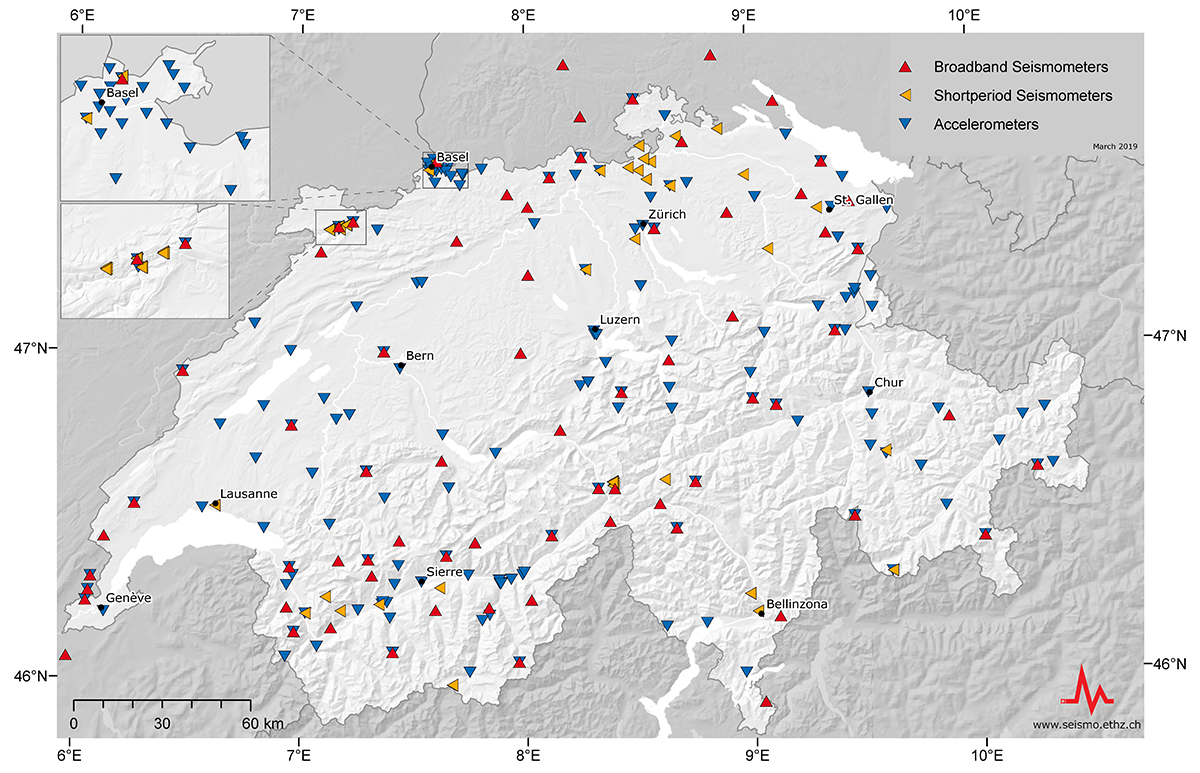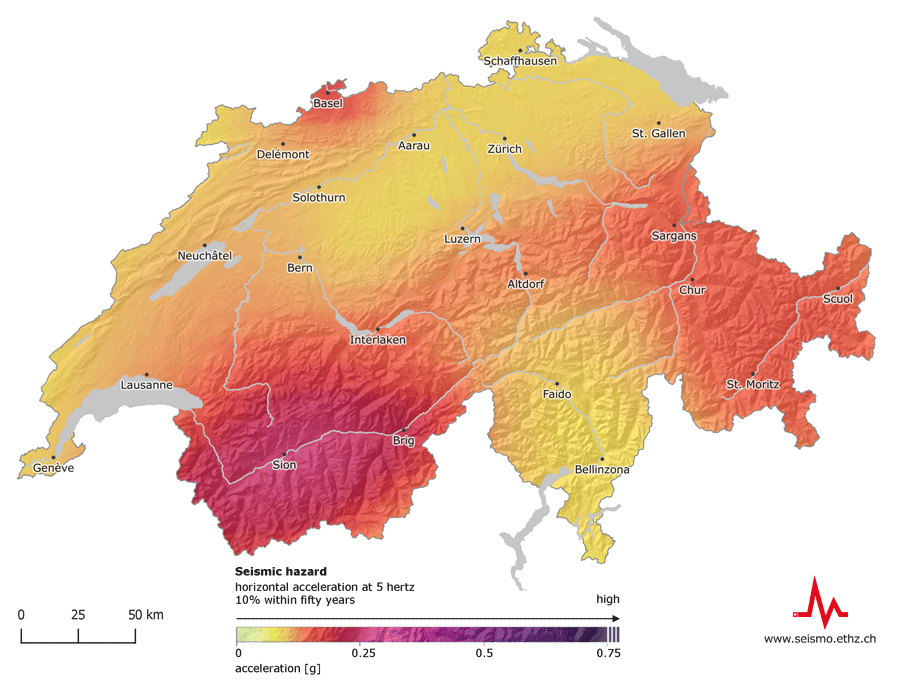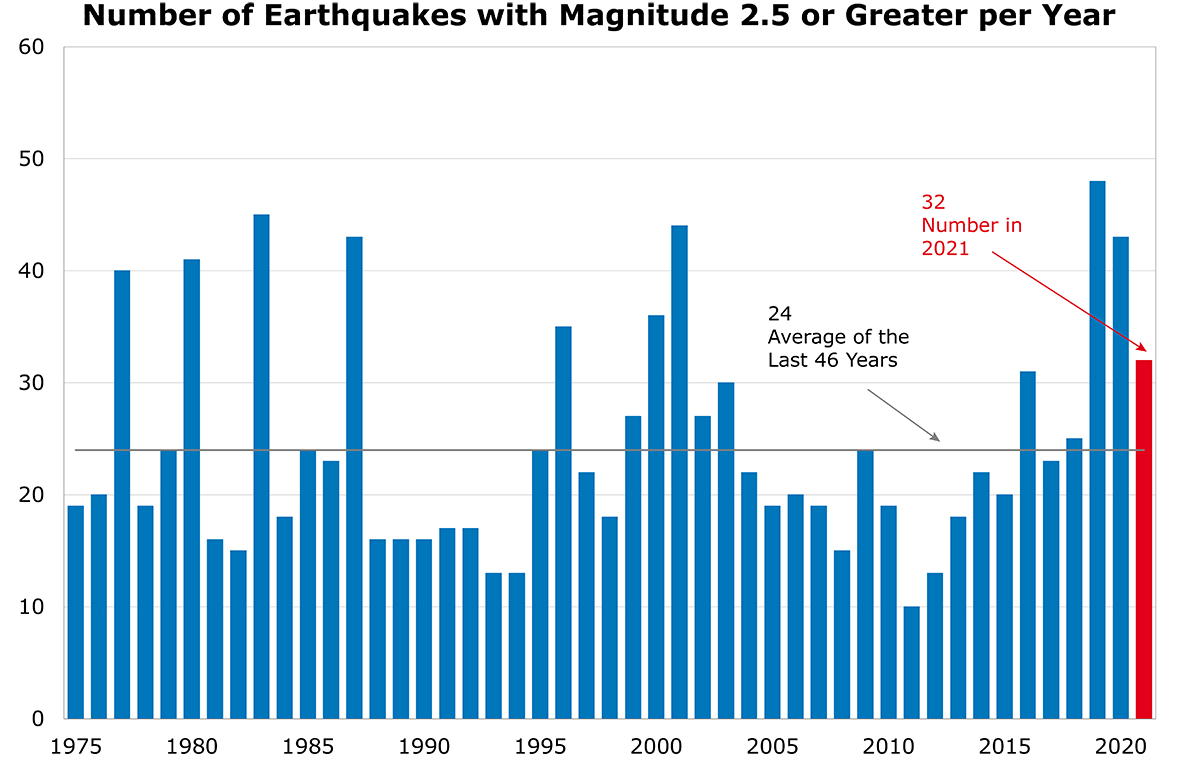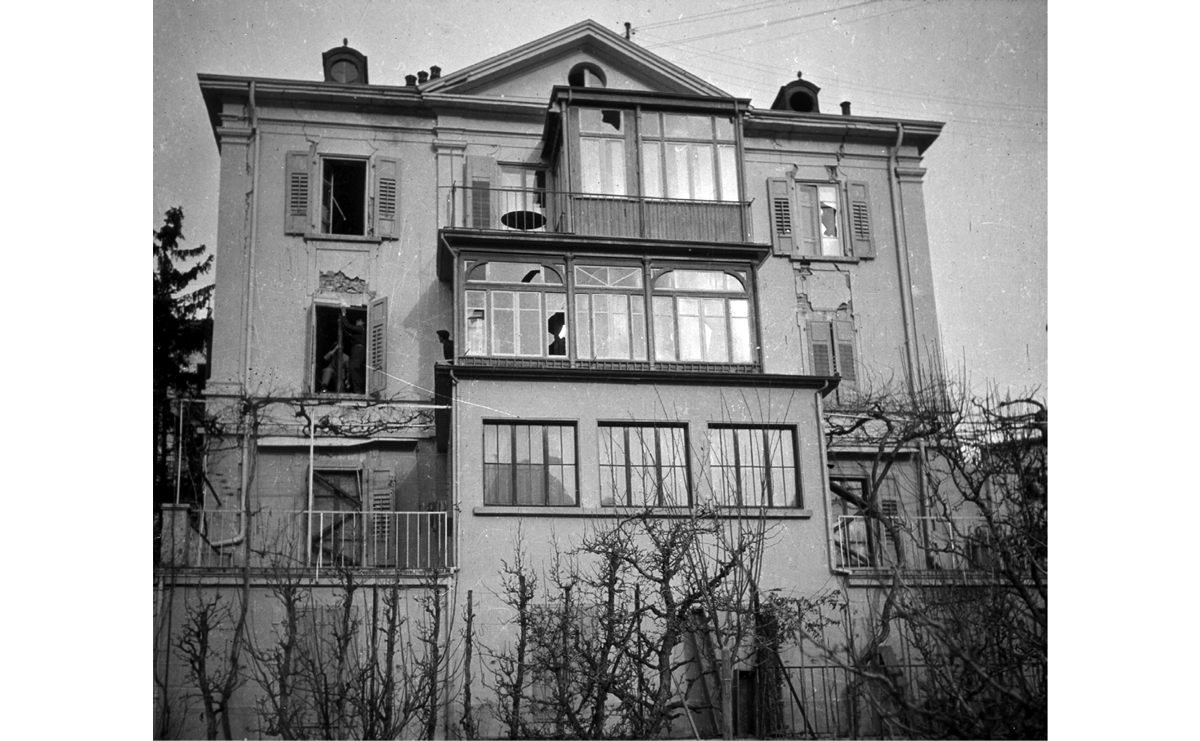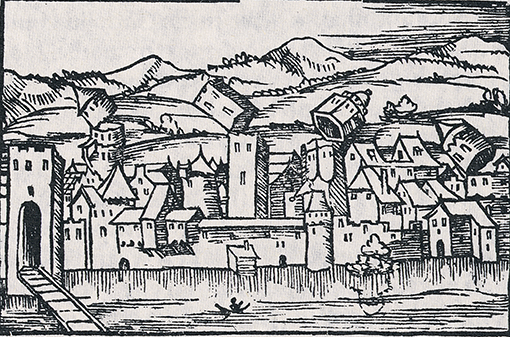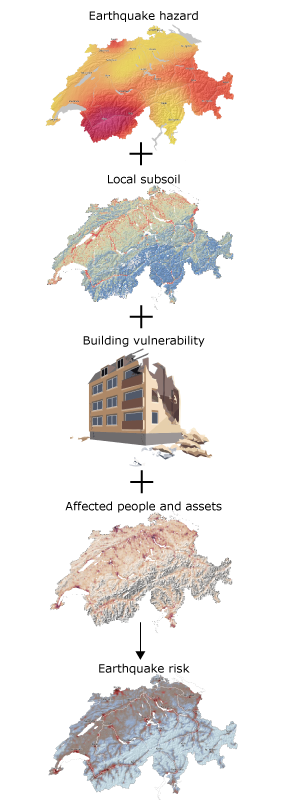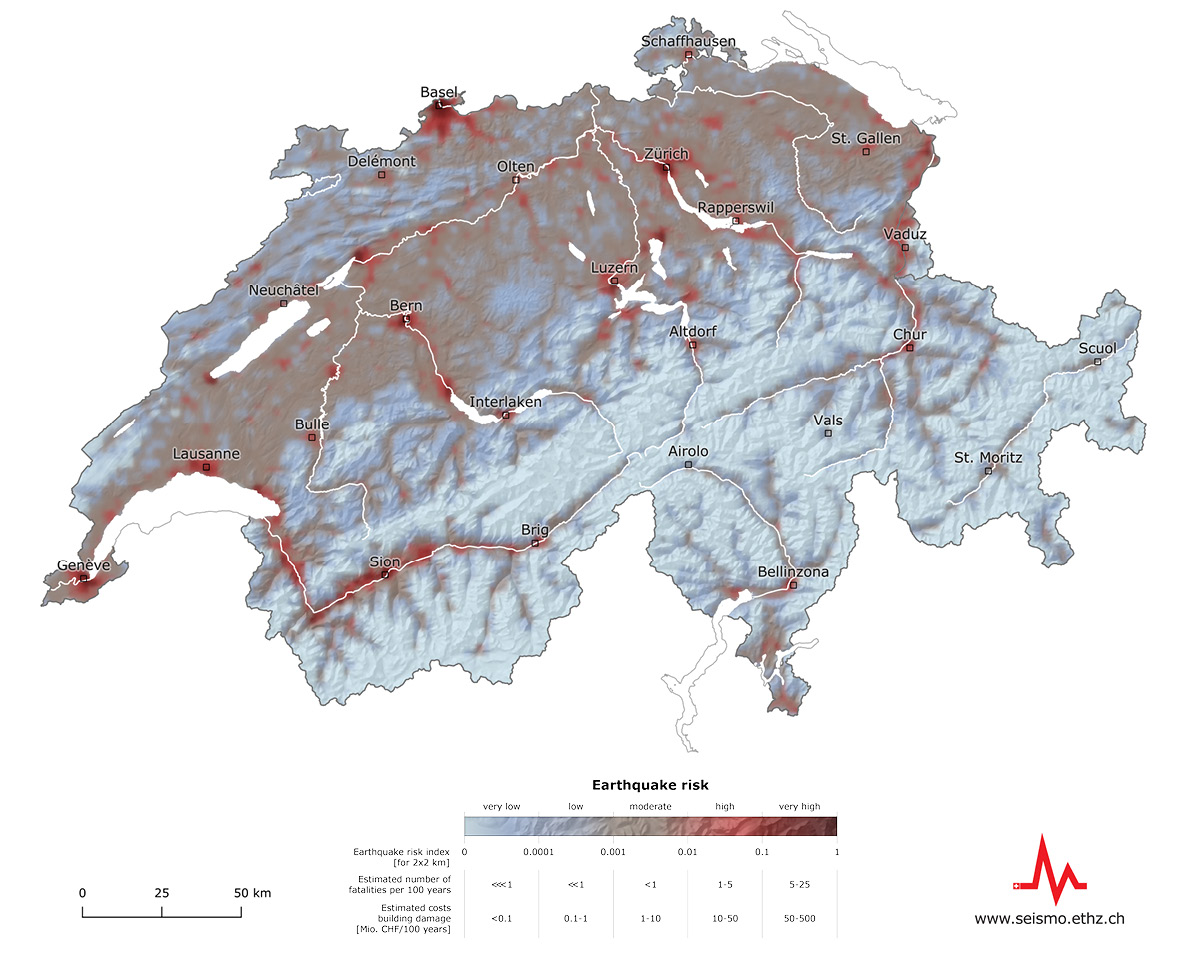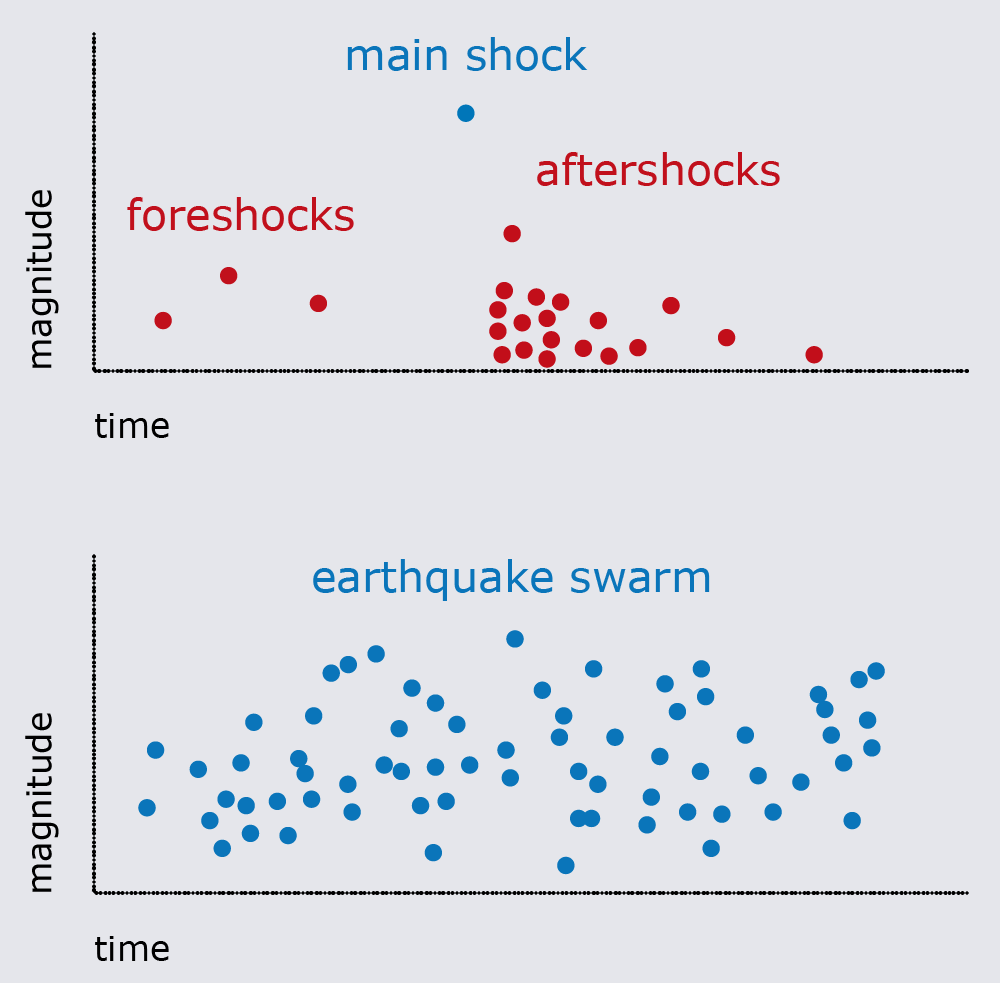SwissEarthquakeExpert
1 How many monitoring stations does the Swiss Seismological Service (SED) use to measure earthquakes in Switzerland?
a) 0 - the SED can use data gathered by equivalent services in other countries.
Sorry, that's incorrect! The correct answer is: b) Over 200
b) Over 200
Correct!
c) 3
Sorry, that's incorrect! The correct answer is: b) Over 150
Learn More
2 How high is the earthquake hazard in Switzerland?
a) Moderate, compared to other European countries
Correct!
b) Very high
Sorry, that's incorrect! The correct answer is: a) Moderate, compared to other European countries
c) Low, no strong earthquakes occur here.
Sorry, that's incorrect! The correct answer is: a) Moderate, compared to other European countries
Learn More
Compared to the rest of Europe, Switzerland is exposed to a moderate seismic hazard, with an evenly distributed earthquake activity, the canton of Valais being the region with the highest hazard, followed by Basel, Graubünden, the St. Galler Rhine Valley and Central Switzerland. No regions of Switzerland are not at risk of any earthquakes at all.
The seismic hazard indicates where within a certain timeframe and how frequently certain shaking is likely to occur. The assessment of the seismic hazard is based on knowledge of tectonics and geology, previous earthquake history, descriptions of damage caused and wave propagation models.
3 How often are earthquakes felt in Switzerland?
a) Roughly once a year
Sorry, that's incorrect! The correct answer is: b) Roughly once a month
b) Roughly once a month
Correct!
c) Roughly once every five years
Sorry, that's incorrect! The correct answer is: b) Roughly once a month
Learn More
On average, the Swiss Seismological Service registers two earthquakes a day in Switzerland and its neighbouring countries, making a total of between 1,000 and 1,500 earthquakes a year. Usually, somewhere between 10 and 20 of these events are strong enough (i.e. have a magnitude of 2.5 or above) to be felt by the local population.
4 Which place in Switzerland has experienced the strongest quakes over the past 100 years?
a) Basel
Sorry, that's incorrect! The correct answer is: b) Sierre
b) Sierre
Correct!
c) St. Gallen
Sorry, that's incorrect! The correct answer is: b) Sierre
Learn More
In the evening of Friday, 25 January 1946, Sierre in the canton of Valais was hit by an earthquake with a magnitude of 5.8.
It was already dark and there was snow on the ground in Sierre. At 18:32 the ground shook for a number of seconds. People ran out into the streets, chimneys and tiles fell from the rooftops and the streets were strewn with rubble. The power supply failed and for 10 minutes the city was plunged into total darkness. Very soon, the telephone lines became so overburdened that for a number of hours great uncertainty and chaos ensued.
Only the next day did the full consequences of the earthquake become apparent: 3 fatalities and 3,500 seriously damaged buildings. The value of the total damage caused would be equivalent to CHF 26 million in today's money.
5 What does the Swiss Seismological Service do when a quake occurs?
a) In each canton it has an emergency team, which inspects buildings for damage.
Sorry, that's incorrect! The correct answer is: c) It immediately alerts the authorities, the general public and the media
b) It alerts the Federal Council and waits until the situation has stabilised.
Sorry, that's incorrect! The correct answer is: c) It immediately alerts the authorities, the general public and the media.
c) It immediately alerts the authorities, the general public and the media.
Correct!
Learn More
Earthquakes can neither be predicted nor prevented. However, the Swiss Seismological Service (SED) monitors ground shaking around the clock. Within approximately 90 seconds of an earthquake, details about the time, location and possible effects appear on the website www.seismo.ethz.ch.
The SED automatically reports any noticeable earthquakes to the authorities and the media. At the same time, this information is transmitted to the SED’s 24-hour on-call service by pager, e-mail and text message. This service is also available to the authorities and the media for further information about current events, and produces background information that is published on the SED website.
In addition, in the event of any earthquakes that cause major damage worldwide, the SED informs the Swiss Humanitarian Aid Unit (SHA).
6 Where did the strongest ever earthquake to hit Switzerland occur?
a) Zug
Sorry, that's incorrect! The correct answer is: b) Basel
b) Basel
Correct!
c) Chur
Sorry, that's incorrect! The correct answer is: b) Basel
Learn More
After at least one foreshock during the afternoon of 18 October 1356, a quake with a magnitude of roughly 6.6 shook the city of Basel at about 22:00. This was the largest historically documented earthquake in Switzerland.
Numerous houses collapsed, causing several fires that took a long time to extinguish (due to the shingle and straw roofs, open fireplaces and heated ovens). Considering the strength of the quake and the destruction it caused, relatively few people fell victim to it, since many had already left their homes after the foreshock.
7 How high is the earthquake risk in Switzerland?
a) High, because earthquakes are among the risks with the greatest extent of damage in Switzerland.
Correct!
b) Low, because all buildings in Switzerland are well constructed and strong earthquakes occur rarely in Switzerland.
Sorry, that's incorrect! The correct answer is: a) High, because earthquakes are among the risks with the greatest extent of damage in Switzerland.
c) High, because of Switzerland's proximity to the volcanoes in Italy.
Sorry, that's incorrect! The correct answer is: a) High, because earthquakes are among the risks with the greatest extent of damage in Switzerland.
Learn More
The 2020 Risk Report published by the Federal Office for Civil Protection (FOCP) ranked earthquakes along with pandemics and power shortages among the greatest risks facing Switzerland. Although they occur less frequently than other natural hazards, they can cause significant damage.
According to the earthquake risk model of Switzerland, over a period of 100 years, earthquakes can be expected to cause economic damage of CHF 11 to 44 billion to buildings and their contents (such as furniture) alone. In total, around 150 to 1,600 people would lose their lives and an estimated 40,000 to 175,000 would become homeless on a short-term or long-term basis. On top of this, there is damage to infrastructure and losses due to other effects of earthquakes such as landslides, fires or business interruptions. However, these are not yet included in the model. The earthquake risk is not evenly distributed over time, but is dominated by rare, catastrophic earthquakes that usually happen without warning.
Earthquake risk is made up of four factors:
- Earthquake hazard
- Local subsoil
- Building vulnerability
- Affected people and assets
8 Where is the earthquake risk highest in Switzerland?
a) The earthquake risk is the same everywhere.
Sorry, that's incorrect! The correct answer is: b) In densely populated areas.
b) In densely populated areas.
Correct!
c) In the mountains.
Sorry, that's incorrect! The correct answer is: b) In densely populated areas.
Learn More
The earthquake risk is greatest in densely populated areas due to the large number of people and buildings. Therefore, the expected effects of earthquakes would be most devastating in such urban areas. Thus, the highest earthquake risk in Switzerland is the cities of Basel, Geneva, Zurich, Lucerne, and Bern, in that order. Although the earthquake hazard in these regions differs, all five cities have, by virtue of their size, a large number of people and assets that would be affected by an earthquake. In addition, these cities have many buildings, some particularly vulnerable and often located on soft ground that amplifies seismic waves.
Earthquake risk (or seismic risk) quantifies the possible effects of earthquakes on buildings and the associated financial and human losses.
9 What is an earthquake swarm?
a) A prize awarded to particularly innovative seismologists (every year in Zurich)
Sorry, that's incorrect! The correct answer is: c) The occurrence of a large number of earthquakes of similar magnitude in the same place within a short timeframe (as for example in Sarnen)
b) Birds that fly away just before an earthquake, because they have already detected the waves in the ground (observed in Lugano).
Sorry, that's incorrect! The correct answer is: c) The occurrence of a large number of earthquakes of similar magnitude in the same place within a short timeframe (as for example in Sarnen).
c) The occurrence of a large number of earthquakes of similar magnitude in the same place within a short timeframe (as for example in Sarnen).
Correct!
Learn More
During so-called earthquake swarms, numerous quakes occur in the same place over a short time, but not in any clear sequence consisting of a foreshock, main quake and aftershock. Earthquake swarms are nothing unusual worldwide, including in Switzerland. Swarm activity usually ends after a few weeks or months, but just occasionally the quakes increase in strength and number over time.
In February 1964, hundreds of earthquakes occurred over several months in the Sarnen region. The two largest, with magnitudes of 5.0 and 5.7 shook the region on 17 February and 14 March respectively. The value of the total damage caused would be equivalent to CHF 16 million in today's money.
Result
Earthquake novice
There's still room for improvement!
Take a look at our section of frequently asked questions (FAQs), which succinctly explains key information on earthquakes. Or build on your knowledge by playing a few earthquake games!
Earthquake apprentice
A respectable result, but you're not yet quite an earthquake expert!
Take a look at our section of frequently asked questions (FAQs), which succinctly explains key information on earthquakes. Or build on your knowledge by playing a few earthquake games!
Earthquake expert
Congratulations, you're very knowledgeable about earthquakes!
Yet there are bound to be a few facts left to learn. For example, in our Snapshots section you can find out what icequakes are and what seismometers are measuring on Mars. Or try playing a few earthquake games!
